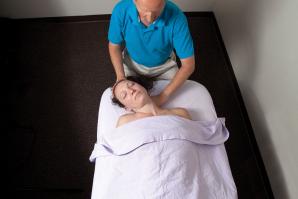Avery Benedict-Hall can’t talk, but when he slides onto a horse every Saturday morning at 11, his audience can hear the sound of his smile: clap, clap, clap. The 9-year-old has a host of neurological disorders, including cerebral palsy, autism and cortical visual impairment. Clapping is a soothing stimulant for many children with autism.
For two years, his mom, Tracey Benedict, has made the weekly trek from Sacramento to the stable at Ride to Walk in Lincoln, so Avery can ride for 30 minutes. The nonprofit’s volunteers walk beside Avery to protect him from falling while he works with a licensed therapist.
At first, staff had to buckle Avery into a high-backed seat to keep him from flinging his torso. Now, he can sit upright and even hold a red rubber ball while riding.
It’s hard to tell how much horse-assisted therapy has helped his day-to-day life, Tracey says, because he sees another half-dozen therapists in various specialties. But now, he can do little things that other parents take for granted, she says, like scooting himself into a restaurant booth. She used to have to lift his limp body to move him.
Ride to Walk was full of stories like Avery’s — until August. The nonprofit served 82 riders this summer, but the state budget forced the Alta California Regional Center to cut funding for all but a couple of riders. Only about half of the parents, including Tracey, could continue with the $50 therapy sessions. At that, the fee only covers half the nonprofit’s cost per ride.
“There are 40 other families out there who know this is a good therapy for their children, but they might be losing their house or losing their job,” says Susan Brouwer, Ride to Walk’s assistant director. “The economy has taken a toll on us all.”
When Alta and Ride to Walk teamed up years ago, the center classified the nonprofit’s activity as recreational instead of therapeutic, which is why funds dropped from $21,000 to $3,000 per month this fall during the state budget crisis. Although the nonprofit employs physical and occupational therapists, it hasn’t been able to change the classification, Brouwer says.
Ride to Walk’s operating budget was around $400,000 in 2008; this year, the nonprofit is roughly $90,000 in the red. Even its annual Boots and Scoots barn dance brought in $20,000 less than last year. Now, Brouwer says she is focused on finding grants and private sponsors for riders; for $2,500, one child can ride for an entire year.
Meanwhile, moms like Tracey will continue to scrape together $200 per month so their children can maintain the physical and emotional benefits of horse-assisted therapy. Tracy says the therapy has also boosted Avery’s self-confidence. He’s interacting more with children his own age, and when he doesn’t feel like doing his schoolwork, he’ll shower his teacher with hugs and kisses. “He knows how to charm the ladies,” she says.
Recommended For You

Hands-On Healing
Can massage therapy change your life?
Tony Mickela doesn’t consider his weekly massage an act of decadent pampering. The 67-year-old retired Sacramento educator instead views the therapy, which he has been receiving for the past 10 years, as an integral part of a healthy lifestyle and his effort to keep an array of health problems at bay.

Putting Children First
What to expect when dealing with Child Protective Services
A report was made to Child Protective Services about our young nephew, claiming an abusive environment created by neglect due to my sister-in-law’s drug addiction. My sister-in-law is obviously very upset, and doesn’t know what to do. We’ve never been through anything like this; what should we expect?


